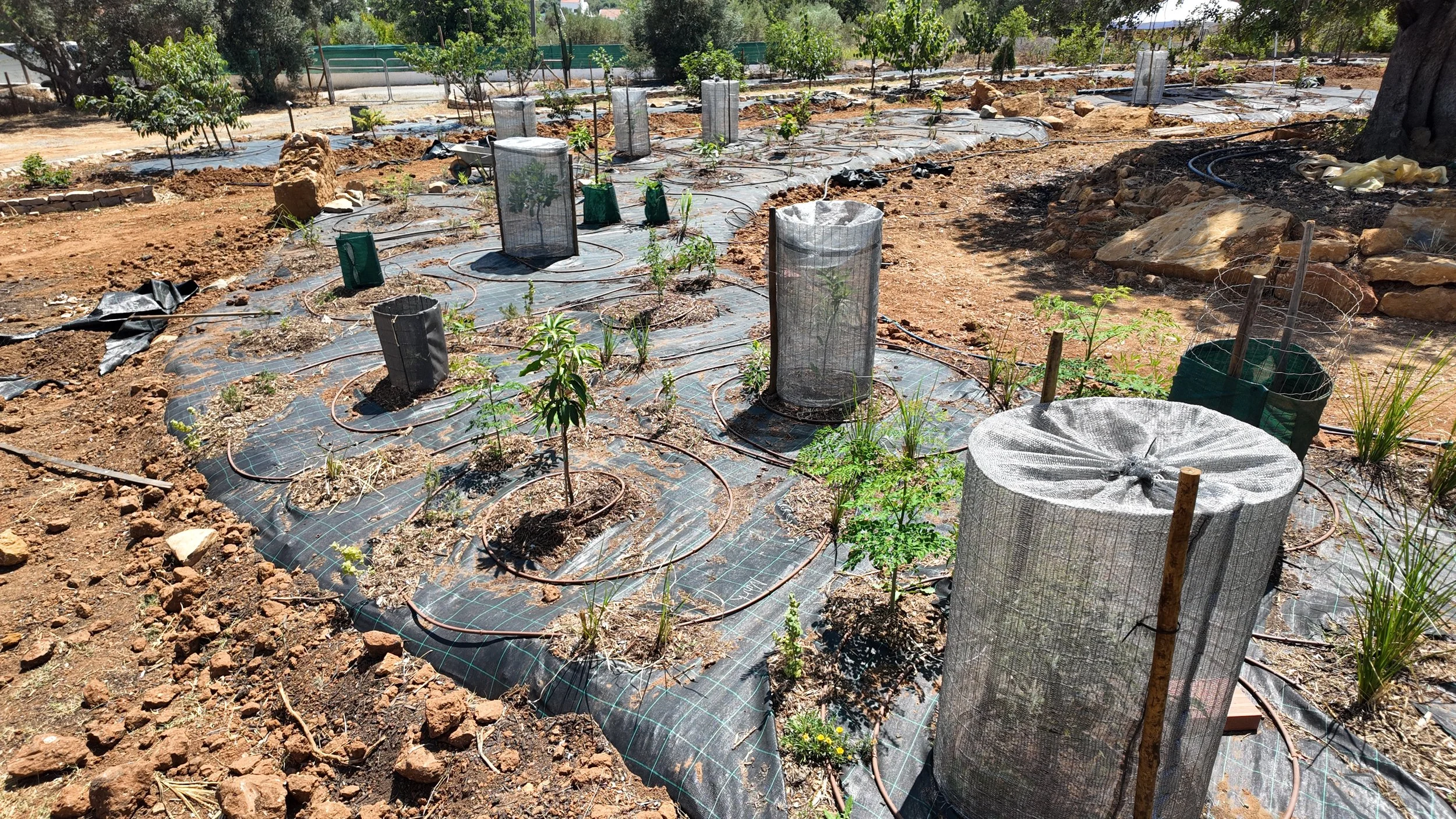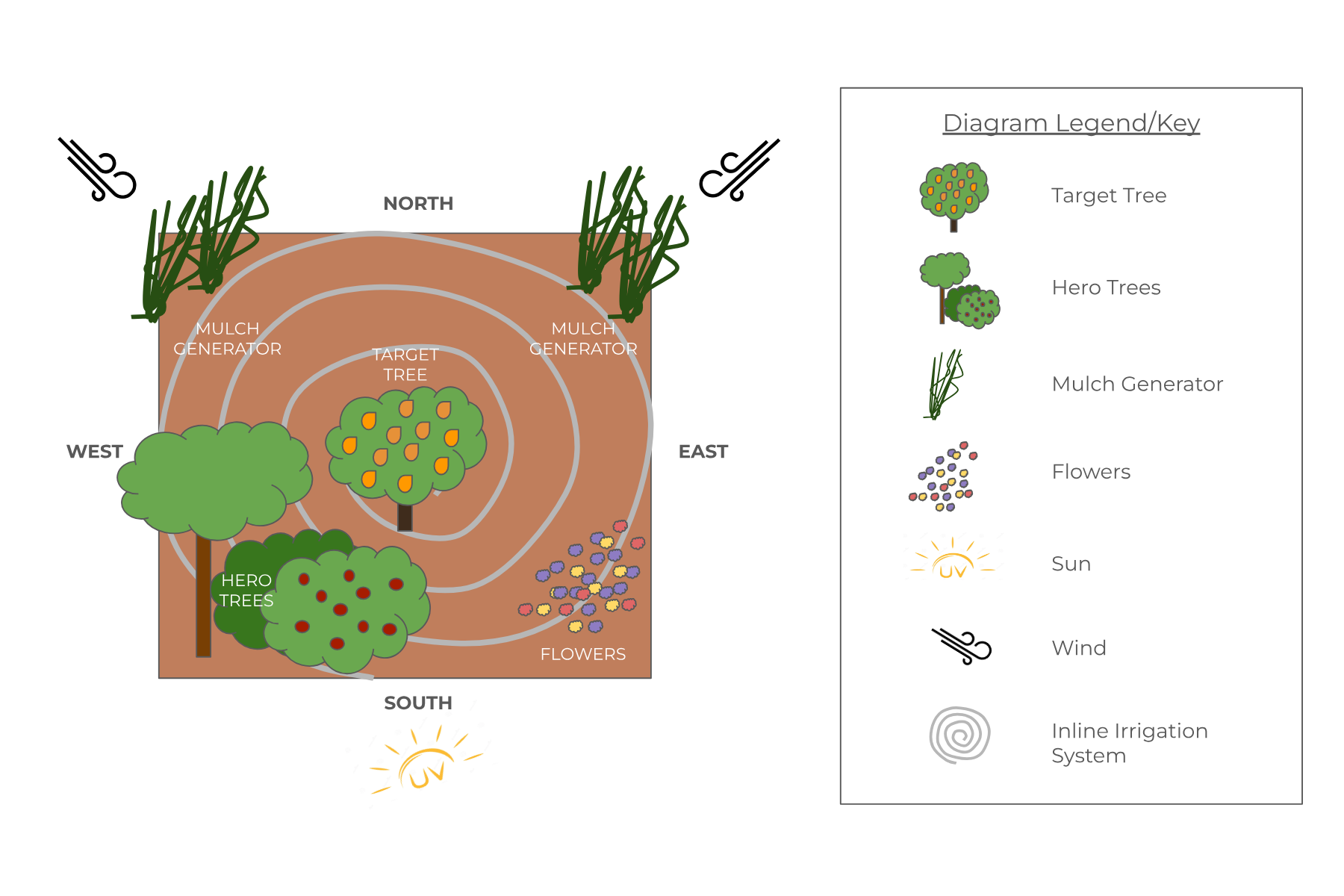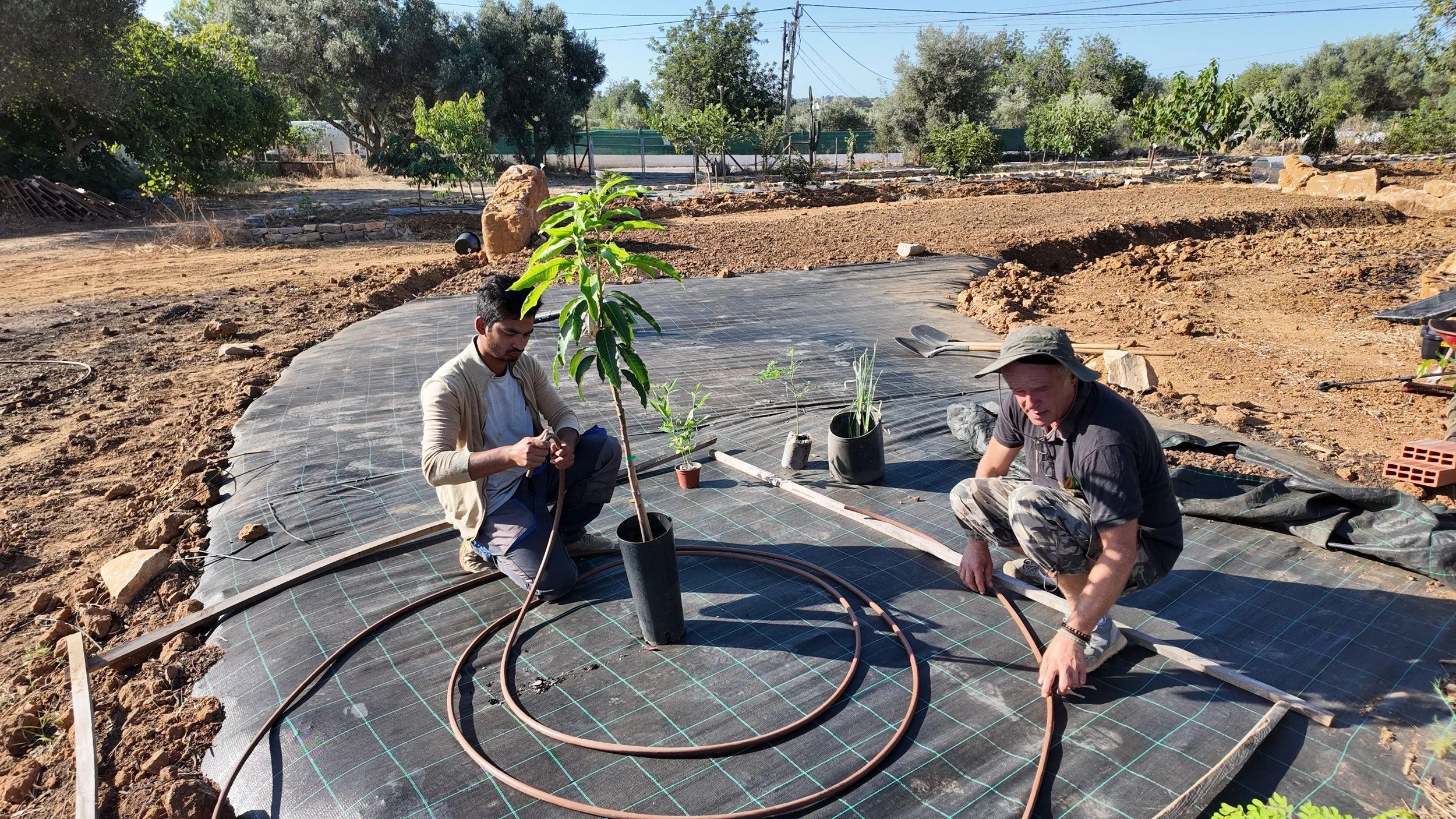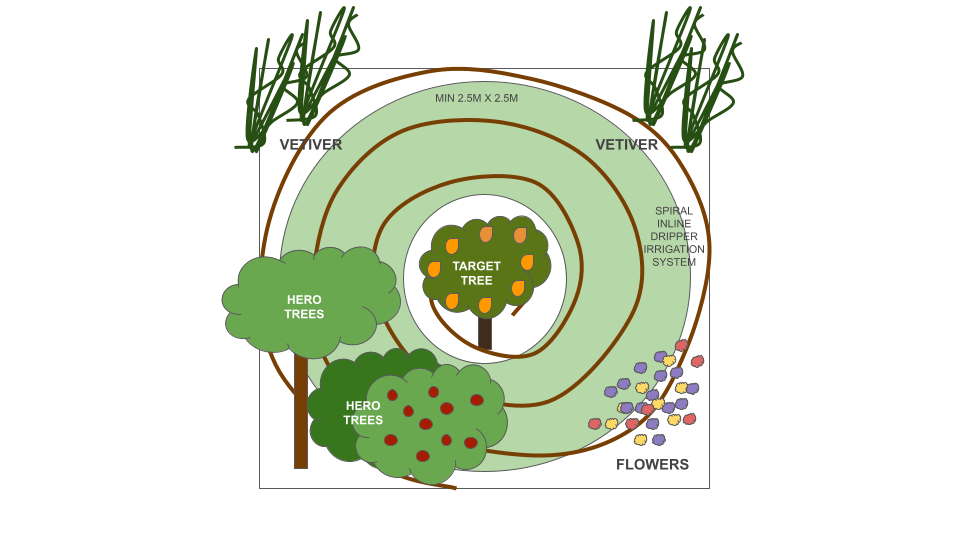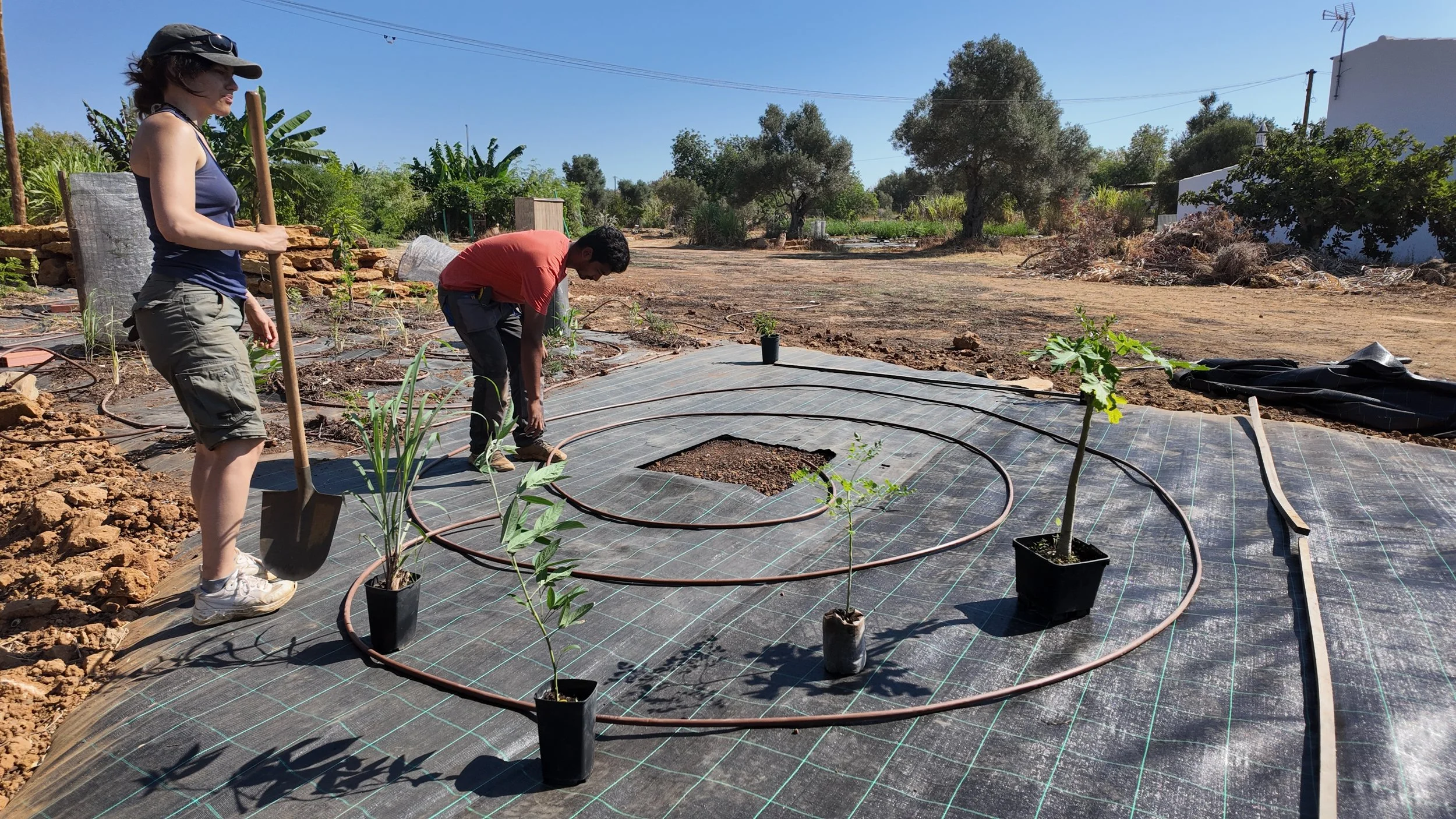Highly Organised & Medium Density - Cocoon Food Forest
Our most advanced Food Forest: easy, step-by-step implementation, predictable, concentrated on our Target Fruit Tree growth and health. We drew the conclusions from our early Food Forest experiments and designed this protocol to better fulfill our objectives, especially the objectives of fruit production, limited water usage and cost.
Cocoon Food Forest Online Course — FREE!
Our very first online course takes you step-by-step along the path of creating a thriving Food Forest, and we have decided to provide it totally free of charge.
Protocol:
Soil preparation: decompaction at 80 cm, 15% plain compost, 5% composted horse manure
Density: 2 plants per m²
Not planted randomly: the idea is to create a “forest environment” around each fruit tree. All target trees are planted in the middle of a minimum area of 6 m² and are surrounded by “helping” plants: a mulch generating plant, selected flowers for pollination and predators, fast growing “hero trees”.
Size: variable (min 6m2 for each target tree)
Assessment: (1 *: low to 5 *: high)
Growth rate: ⧫ ⧫ ⧫
Probably less fast during the first year than in denser Food forests.Resilience (biodiversity and quality of soil microbiology): ⧫ ⧫ ⧫
Probably very good, providing habitat for several insects, birds, frogs, etc. The more so if several Cocoon Food Forests are planted contiguously.Quantity, quality, and predictability of fruit production: ⧫ ⧫ ⧫ ⧫ ⧫
To be assessed. Expected results are that the sun requirement of each plant is taken into account, and enough space is available for better development of target fruit trees. We expect much better results than in a randomly planted food forest.Maintenance: ⧫ ⧫
Easy to very easy maintenance, totally predictable.Cost-effectiveness: ⧫
Not very expensive.
Scalability: ⧫ ⧫ ⧫ ⧫ ⧫
Easier to implement on a large area.Water efficiency: ⧫ ⧫ ⧫ ⧫ ⧫
Approx. 4 liter per m2 (24 liters per day for a 6m2 cocoon food forest for around 12 plants).
Context and Considerations
The Cocoon Food Forest is a powerful solution to help your fruit trees thrive. It is designed for Mediterranean climates but can easily be adapted to other climates.
Focus Your Efforts: Concentrate on one target fruit tree at a time, providing optimal conditions for rapid and healthy growth. Once successful, move on to your next Cocoon Food Forest. Soon, you'll cultivate a large, beautiful, resilient, and productive food forest. We could also call our approach the “All-for-One Food Forest” or the “Fruit Tree Accelerator”!
Simple and Effective: Our step-by-step approach is well-documented, easy to implement, and designed for easy replication.
Customized Solutions:
Is your garden very windy?
Is your borehole water poor quality or slightly saline?
Is your soil very alkaline or acidic?
Do you want to cultivate rare subtropical fruit trees?
Do you want to cultivate subtropical fruit trees that are slightly frost tolerant?
Our Cocoon Food Forest Manual will guide you in adapting to your specific conditions and offers ready-to-implement kits for various scenarios.
The Cocoon Food Forest has been successfully implemented in our botanical garden, and we are excited to share this innovative design with you. Transform your garden into a thriving oasis with our proven approach!
Objectives:
Multiple consultancies and our daily work with fruit trees have led us to believe that these are the objectives most people have for their gardens.
Fast and healthy growth of your target fruit trees
Enhancing resilience through increased biodiversity and improved soil microbiology
Ease of harvest and maintenance
Scalability and cost-effectiveness
Organic aesthetic design (following curves)
Water-sparing, long-lasting irrigation system
Summary:
In each Cocoon Food Forest, we recreate a medium-intensity forest environment using four types of plants based on their documented beneficial features:
The Target Tree: This is the fruit tree you love and wish to grow quickly and produce abundantly.
The Flowers: These plants attract a variety of pollinators and biological predators. We use the scientific research from Koppert Laboratory to select the most suitable flowers for Mediterranean climates.
The Mulching Generator: We chose Vetiver (Chrysopogon zizanioides) because it is proven to be highly beneficial. It thrives on all terrains, is drought-resistant, and non-invasive.
The Hero Trees: These trees create a temporary protective environment for your target tree and greatly enhance soil microbiology. They are edible perennials selected based on specific features: not long-lived, fast-growing, non-invasive root systems, and ideally, nitrogen fixers.
Together, these plants form a guild. By planting multiple Cocoon Food Forests, you create a large and diverse Food Forest.
Our design involves the following steps to accelerate the growth of the target tree, improve soil quality, and facilitate maintenance and harvest:
Conducting an in-depth study of the target tree's requirements (sun, water, soil, and space needed).
Thorough initial soil preparation.
Dense planting (on average, 2 plants per square meter).
Using three layers of plants: creeping flowers, bushes, and taller trees.
Our first online Fruit Tree Academy Course where we give you an extensive overview of our most efficient way to grow Food Trees in a Mediterranean climate.
Make sure to check out our main article on Miyawaki-inspired Food Forests and our Theoretical Foundations where we explain the whole concept and how we’re putting it in action at the Orchard of Flavours site. Also, don’t forget to compare this Experiment with all the others already growing:
Organised & Low Density Food Forest
Organised & High Density Food Forest
Highly Organised & Medium Density Food Forest
This article was compiled by Miguel COTTON. If you have any questions or suggestions, do not hesitate to contact us. Please write us anytime at miguel@orchardofflavours.com

